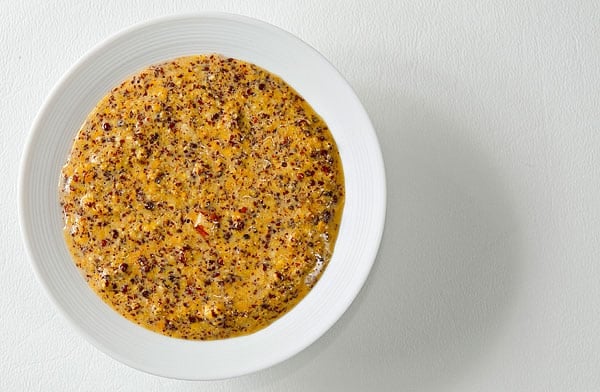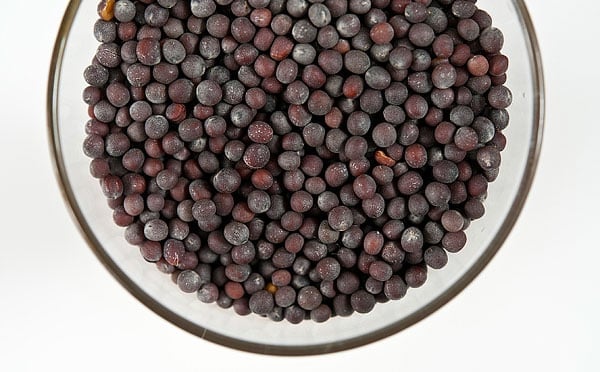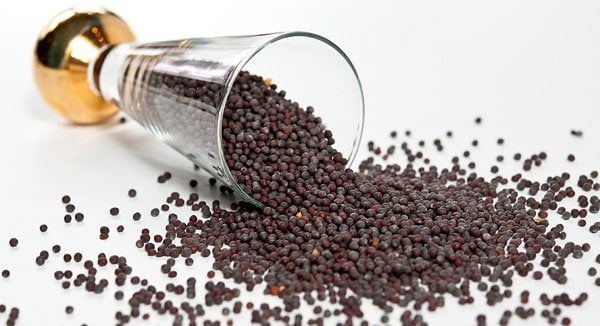As an Amazon Associate I earn from qualifying purchases.

What do you mean you can make mustard at home? It was all I could do to say, “Uh… how did you think it was made? By mustard elves under a tree?” Thankfully, I am older and nicer than I once was. Instead, I said, “Why yes, and it is really, really easy to make.”
I had this conversation with another food blogger, and I tell you this because even for even a food person to not know how to make mustard tells me that it must appear to be magic to most people. But I gotta tell ya folks, it ain’t. If you have mustard seed and water, you can make mustard. It’s that easy. And pretty much every culture in the Northern Hemisphere has done so: Mustard is to the North what chiles are to the tropics.
Mustard is a condiment of a thousand faces. Some are smooth, others almost entirely made from barely cracked seeds. Vinegar is often used, but wine, beer, grape must, and even fruit juices are used to moisten the seeds. Sweetness is usually achieved by adding honey; an American “honey mustard” can be a 1:1 ratio of mustard to honey. A Bavarian sweet mustard, however, uses only sugar and water: no acid, no honey. Italians put fruit preserves in their mustard, a practice I wholeheartedly endorse.
Mustard is one of Europe’s few native spices, although mustard also has been used in Chinese cooking for around 2,500 years as well. Ancient Rome was quite the hotbed of mustard-making, and it is Rome that gives us our name for mustard: It is a contraction of mustum ardens, or “hot must;” the Romans often added crushed mustard seeds to unfermented crushed grapes. I’ve recreated a different Roman recipe for mustard that uses almonds, pine nuts, mustard seed and red wine vinegar. The ferocious bite of this mustard — it should be made with black mustard seeds, the hottest variety — is mellowed by the richness of the nuts. It’s a great accompaniment to roasted meats.
The basic idea behind making mustard is this: Grind seeds and add cool liquid. At its most basic, this is all mustard is. Both Chinese and English mustard (think Coleman’s) is nothing more than water and mustard powder. But there are some things you need to know to make great mustard.
First, you need cold liquid. What gives mustard its bite is a chemical inside the seeds reacting with cool or cold liquid. You also need to break the seeds to get at the fiery chemical — it’s like cutting an onion. Heat damages this reaction, however, so to make a hot mustard use cold water, and warm water for a more mellow mustard. Mustard sauces lose punch when long-cooked, and should always have a little extra fresh mustard tossed in at the end of cooking.
This reaction is volatile, too. Left alone, your mustard will lose its bite in a few days, or in some cases even hours. But adding an acid, most often vinegar, stops and sets the reaction in place — this is precisely what happens with horseradish as well. Adding salt not only improves the flavor, but also helps preserve the mustard, too.
Once made, mustard is nearly invulnerable to deterioration. Mustard is one of the more powerful anti-microbial plants we know of, and, considering it is mixed with vinegar and salt, it becomes a heady mix no wee beastie can survive in. It is said that mustard will never go bad, although it can dry out.
You have three choices when it comes to which variety of mustard seed you use: White, brown and black. White mustard undergoes a different, milder reaction than do brown or black mustards, which are far zingier. American yellow mustard is made with white mustard seed and turmeric, brown mustards are in most of your better mustards, and black mustard is used in hot mustards or in Indian cuisine.

Incidentally, the wild mustard all over California is black mustard. You can thank Father Junipero Serra for that one: He used mustard, which grows like a weed, to mark his travels in Alta California 250 years ago.
The famous Grey Poupon mustard — Dijon has been a center of mustard-making for nearly a millennia now — is traditionally made with stone ground brown mustard and verjus, the tart juice of unripe grapes. I prefer this style of mustard, and most of my homemade mustards are grainy like Dijon. I grind my seeds with a spice grinder, but you could get all old school and use a mortar and pestle.
The best mustards, in my opinion, combine brown or black mustard seeds with yellow mustard powder: The two sets of chemical reactions complement each other and made a more complex mustard.
Always add water or a non-acidic liquid first, let the mixture sit for 10 minutes or so, then add the acid (vinegar, verjus, lemon juice, etc).
Add salt to taste, but it’s typically about 1 to 2 teaspoons per cup of prepared mustard.
Finally, let your mustard set in the fridge or in a cool place for at least a day before you serve it. Bitterness is a byproduct of the mustard reaction, but that bitterness fades after a day or so. Pure mustards can be kept at room temperature, but mustards with other ingredients, like the Roman nut mustard I mention above, should be kept in the fridge.
So there you have it. Easy-peasy. Now you really have no reason to ever buy mustard again.

[recipe_name]Basic Country Mustard[/recipe_name]
[summary]What could be easier than making your own mustard? No, really. It is stupid easy. Grind some mustard seeds, mix with mustard powder and some liquid and you’re done. There is no earthly reason to ever buy mustard once you learn this basic recipe. Endless variations exist. Change the liquid and you change the mustard. Grind the mustard seeds a lot or a little and you change the texture — or skip the whole seeds altogether and use just mustard powder.
Which type of mustard seed do you use? Yellow is what we Americans are most used to, but brown is spicier, more mustardy. Black mustard is stronger still, and it grows wild over much of North America; gather the seeds in late summer or early fall.
Want herbs in there? Go for it. Like honey mustard? Pour some in. Want your mustard even spicier? Add chiles or freshly grated horseradish. I even made a mustard with fresh grape juice from my backyard wine grapes. I called it Deep Purple. Weird-looking, but delicious.
The one caveat to making mustard at home is to wait. You cannot eat it the day you make it. Mustard needs to marinate to dissipate its bitterness. Try it: Eat a little dab right after you make it, then a day or two later. The difference is dramatic.[/summary]
[yield]Makes about 1 cup.[/yield]
Prep Time:[preptime time=12H] 12 hours[/preptime]
- [ingredient][amount]6 tablespoons[/amount] [item]mustard seeds[/item] [/ingredient]
- [ingredient][amount]1/2 cup[/amount] [item]mustard powder[/item] [/ingredient]
- [ingredient][amount]3 tablespoons[/amount] [item]vinegar[/item] (cider, white wine or sherry) [/ingredient]
- [ingredient][amount]1/2 cup[/amount] [item]white wine[/item] or water [/ingredient]
- [ingredient][amount]2 teaspoons[/amount] [item]salt[/item] [/ingredient]
OPTIONAL
- [ingredient][amount]2 tablespoons[/amount] [item]honey[/item] [/ingredient]
- [ingredient][amount]2 tablespoons[/amount] grated [item]fresh horseradish[/item] [/ingredient]
- 1/4 cup minced fresh herbs (really any kind)
[instructions]
- Grind the whole mustard seeds for a few seconds in a spice or coffee grinder, or by hand with a mortar and pestle. You want them mostly whole because you are using mustard powder, too.
- Pour the semi-ground seeds into a bowl and add the salt and mustard powder. If using, add one of the optional ingredients, too.
- Pour in the vinegar and wine or water, then stir well. When everything is incorporated, pour into a glass jar and store in the fridge. Wait at least 12 hours before using. Mustard made this way will last a year in the fridge.
[/instructions]




Big Onion: Sounds to me like you had old mustard, which had dried out. Just add more liquid, a little at a time, until you get the consistency you want. It’s not an exact science. 😉
I made this and didn’t have great success … I had an abundance of whole mustard seed so I ground a bunch into a fine powder and used that for the mustard powder. I measured out the seeds and hand ground with mortar and pestle. Keeping all the same measurements, what I got was a solid, chunky mass. I added more wine, more vinegar. Soaked it right up.
Did I go wrong somewhere?
hello
this basic mustard recipe excites me as it will be my first mustard making experience. Coincidentally I moved to an island In mexico where buying fine mustard is uncommon. Two questions before I start: I am unable to find mustard powder, can I double the seed amount to compensate? Reading other recipes, is it necessary to soak the seed before I use it?
Thank you for this reioe!
I need to learn to cook with no salt. Will this mustard (basic) be eatable and not go bad if made salt free? Have to find some way to get foods spiced up.
Thanks for this recipe. I came across it looking for a substitute for a made-from-scratch whole grain mustard that a bar I used to work in made. We served it with soft warm pretzels and a side of cheese! It was so spicy, it could open up your sinuses 🙂 I can’t wait to make this at home.
Just discovered this site and it’s really excellent. I used to make my own mustard a few years ago (I wish I had this site then, with all the easy directions and trouble-shooting!) and am now looking to get back into it and broaden my skills. I’ve never attempted a fruit mustard–if I’m trying to keep a fruit mustard for a few weeks/months, do I have to worry about botulism? Is there an amount of vinegar that I have to stay above? And must work with low acid fruits require any extra compensation to keep the acid levels up (more vinegar, etc.) to stay safe? In the past, I never canned my mustards (i boiled the jars and lids, but not the mustards themselves as I also read that canning does alter the taste and wasn’t necessary), so is the answer just to can to be on the safe side? Can fruit mustards be as shelf-stable as the rest if done safely, or are they by their nature more perishable?
I made some mustard & it is too thin, is there a trick to thicken it up?
Used the recipe last month. Today I’m having to make some more. The mustard was too good to last long. 😉
Michelle: Mustard doesn’t really go bad, so you can keep it at room temperature for a while. I’d just close the jars tightly and mail it away. Tell whoever is getting the mustard to put it in the fridge once opened.
I would like to make the mustard and mail it to my family in Florida, but I saw that it needs to be refrigerated, but can be sealed in a jar. How do you seal it so it won’t go bad out of the refrigerator. I have never done this before. Thanks.
This is a great! Loved reading all the tips. I made an excellent mustard. I used 1/4 cup yellow mustard seed and 1/4 cup brown mustard seed. I got the seeds from Penzeys spices. they are on line. I mixed 1/3 c white wine, 1/3 c cider vinegar and 1/3 c water . I added a tsp of sea salt . I put everything in a tight lidded jar and stored hid it away for two weeks in a cool dark cabinet. I blended it in a processor with a little dry sherry until semi pulverized and put it back in the jar and in the fridge . Ready to use in day or two! Yum!
Eva: Thanks for the tip! I normally like grainy mustard, but that’s a good solution if I want a smooth one.
Karen: Sadly, no. Sorry!
One year I made a selection of mustards for gifts – one of them was a cantalope mustard – now I cannot find the recipe anywhere – any ideas?????
I’ve been making mustard for a while now. I use a stick blender after soaking the seeds. Super easy, and you have *some* control over the grainy-ness.
Oh man, why am I not surprised?! I’m embarking on a little mustard making today and thought I’d round up some other peoples thoughts/’recipes’ and you were the first website/blog to pop up. Not only is your suggested basic recipe wonderful but your entire blog entry is a perfect ‘101’… not that I doubted it would be. Thanks once again!
First of all, I have to say thank you for such a great post. I am just beginning to get into mustard making and this is very informative.
However, I must disagree with your closing statement that there is no reason to ever buy mustard again. The reason is to try all the great concoctions that others have made! Just stop by the National Mustard Museum (relocated to Middleton, WI from Mt. Horeb) and you will get a taste (literally) of many of the great mustards from around the world. One might still argue that after tasting a free sample you may refrain from buying in an attempt to replicate the mustard on your own, but of course I like to support the museum.
Hank, great post!
Just a copule of questions: could you please provide receipt by weight (american or imperial, metrical even better!) instead of volume? I really find it hard to deal with cup-spoons etc volumes! Italian cups may be very different by american ones 🙂
Is there a general rule when planning a mustard receipe? What I cannot tacke from your receipes is the ratio (if any) for water to seeds to winegar etc.
Many thanks, Enrico
Jenifer: Mustard will not go bad, so you don’t really need to can it in the traditional sense. But if you wanted to get that sturdy seal, I’d water bath it for 5-8 minutes. Heating mustard really affects it flavor, though, so I’d be careful and do a test batch first.
I wanted to make some mustard to give as gifts for Christmas this year. I tried a recipe for Honey Mustard that I found on another site. It heats the mustard to thicken it and it turned out well…bad. So I would like to try your recipe since so many other people seem to like it. Can I water bath can it after is it made? I would like to seal the jars that I give as gifts. Partially so they are sealed and partially so I don’t have to buy “fancy” lids for the jelly jars I was going to use. Thanks in advance for your response.
Mustard greens are quite tasty also and easy to grow.